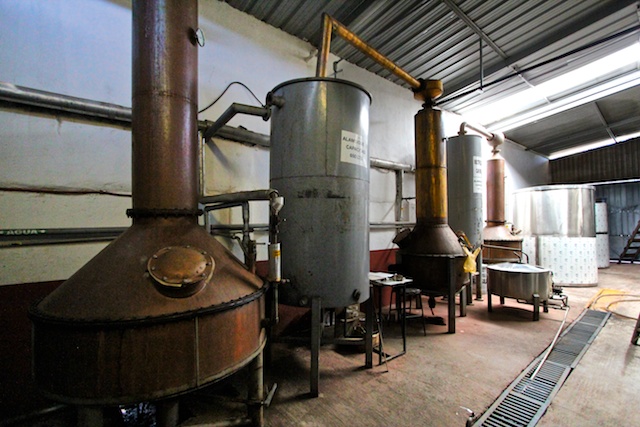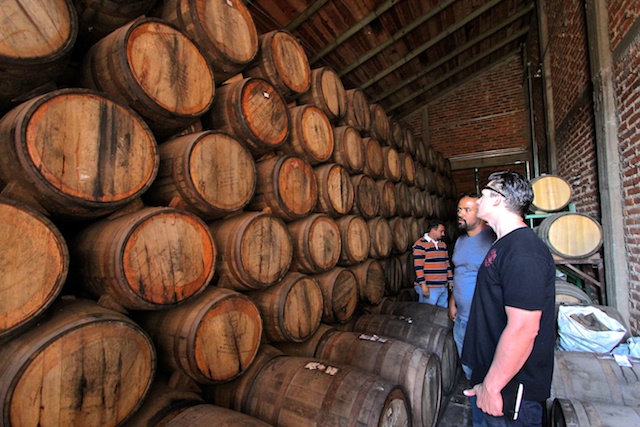Jalisco: Day 4 - Jesus-Maria & Arandas

Good morning!
As I once learned from my father-in-law, there's nothing like birria for breakfast after a long night of drinking. The Mexican soup made from stewed goat and red chili is a favorite of his, and now mine as well. We rose from our first real night of slumber at Enrique's house, threw our bags in the car, and headed down into the town of Atotonilco El Alto for some serious goat action; the soft and tender meat falling apart in our mouths as we dunked corn tortillas and drank Coca-Cola (or beer, even at 9:30 AM). Enrique said he would meet us later for lunch, so we departed and headed north, even further into the mountains, to visit the town of Jesus-Maria and the El Paraiso distillery that produces ArteNOM's 1580 blanco tequila.

What was once known as Rancho El Olvido and NOM 1079 is now known as Rancho Sagrado Corazon de Jesus (the Ranch of the Sacred Heart of Jesus) and goes by the NOM number 1580. The decision to switch the NOM number had to do with a desire to distance the distillery with brands it was no longer doing business with, even though the ownership and tequila remain the same. There are all kinds of liberties distilleries can take with NOM numbers besides filing for a replacement, so you can't depend on them for everything -- even the basic principle they're supposed to represent: where the tequila was actually made. For example, you can use one NOM number, but still purchase tequila from another distillery, mix it in, and never be forced to list that on the label. If you think every drop of Patron is actually made at Patron distillery, well...

Just to make sure I'm up front with you here: El Paraiso makes what is my absolute favorite tequila in the world! I was super-pumped to finally get up into the mountains and get a look at what makes this tequila what it is: the high-elevation agave. As you drive up to the distillery, along the long dirt road extending from the highway, you can see the expansive campos and the vibrant red soil, rich with iron and magnesium.

And then you finally get to see them up close, at the distillery, being hacked up with an ax and fed into the oven. The piñas are incredibly small compared to the agave we saw at the other distilleries, but the flavors are incredibly concentrated as a result. Jake told me he's never seen piñas that look and taste like this anywhere else; it's part of what makes this tequila so special.

Some of the guys working on site pulled one out of the horno and let us rip off a piece. We chewed the fleshy, fibrous pulp and released the intensely-sweet juice into our mouths. The smell of fruity, roasted agave permeated everything at El Paraiso and reminded me almost exactly of the aromas emanating from my bottle of ArteNOM 1580 blanco sitting at home. You know you're at a great distillery when the actual product tastes as good as the distillery smells; it means they're distilling with supreme skill.

The fermentation at El Paraiso takes place in large stainless steel vats, but the entire operation is pretty compact; as Jake said to me, "this is the most boutique distillery we work with in Jalisco." It's a small, but efficient operation.

Just across from the tanks are the five operating pot stills -- three wash stills (which they call destrozadores) and two copper spirit stills. The entire production is all snuggly fit under one roof.

Everything about NOM 1580 is picturesque and beautiful; it's definitely where the romantic idea of a colonial hacienda and serious tequila distillation embrace in passionate, love-filled outpouring of emotion. Or maybe that was just me. The house next door is filled with antique furniture and photos from the olden days of production in Jesus-Maria.

The red soil of Los Altos extends down the hill from Jesus-Maria and into the town of Arandas: a mecca for Highland tequila production that includes Cazadores and La Alteña -- the home of Ocho and Tapatío. We made the short trip in no time at all, pulling into the Feliciano Vivanco distillery; the home of ArteNOM 1414 reposado.

Sergio and Jose Manual Vivanco are quite popular these days. Besides the ArteNOM reposado, they also make the entire line of Siembra Azul tequilas for David Suro and the lovely Gran Dovejo tequilas that we love so much at K&L. There's a reason why people want to work with these guys: their tequila is amazing.

As Sergio Vivanco talked about in my interview with him last September, part of what makes the Vivanco tequilas so special is their yeast production and fermentation process. They actually plant citrus trees along side their agave fields so that the pollen will drop down and spread onto the agave leaves; encouraging the cultivation of natural airborne yeast in the campos. When the agave is harvested, they scrape the leaves and collect the residue in a petri dish where they then begin a strain for fermentation.

Vivanco distillery ages most of their spirit in used Jack Daniels barrels, adding a soft and subtly-sweet touch to their wonderfully delicate reposado expressions. We tasted their Viva Mexico brand at 38% and found the reposado to be the best of that portfolio as well. It seems Jake and Jose knew exactly what they were doing when they selected the ArteNOM 1414.

After lunch it was time to head back into town and meet up with Enrique and Chava one last time before we left for Guadalajara. Chava brought more cheese with him!! If that wasn't enough, we were eating at the spot in Arandas known for the best carnitas in the area.

We said our goodbyes, piled into the car, our bellies full, and made our way back west, through the beautiful valleys of the Highlands, and into the sprawling metropolis. We're lodged up at the hotel downtown, finally catching our breath after what has been a whirlwind, four-day tour through Mexico's most famous spirits-producing regions. I've got a few more photos to post before we're all said and done, but we'll be home early tomorrow morning to enjoy a Sunday back with family and friends.
-David Driscoll
